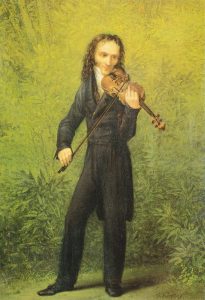Classical music is rich with history of magnificent music, compelling divas, and innovative composers. Not every world premiere was grand, however. This Month in Classical Music History is a series dedicated to finding stories of the good, the bad, and the downright weird. This month read about the first opera composed in the New World, the life of the violin maker Guarneri del Gesù, and Beethoven’s last will and testament.
October: This Month in Classical Music History
Premiere of Tomas de Torrejón y Velasco’s La púrpura de la rosa in Lima, Peru, October 19, 1701.
Tomas de Torrejón y Velasco was a Spanish composer and organist. He served the viceroy of Peru, and was the maestro de capilla at the Cathedral of Lima. Torrejón is most known for his opera, La púrpura de la rosa (The Blood of the Rose), which was based on the libretto written by Calderón de la Barca some 40 years prior. Calderón’s version was the first opera written in Spain. The original music was lost, however, so Torrejón rewrote the opera for his audience in Latin America. Torrejón’s La púrpura de la rosa is the first known opera to be composed and performed in the Western Hemisphere. The work premiered in Lima, Peru on October 19, 1701 to commemorate the first anniversary of the succession of King Felipe V to the Spanish throne.
 Torrejón was in an interesting position, because his opera had two purposes. One was explicit: to honor King Felipe V with a dedication in the score and through praise sung in the loa (overture). The other, more subtle goal was to convince Hispanic audiences in the New World to support the new king, who was of French descent. Opera was a new art form only just coming to popularity in the courts of Italy and France. To ease his audience into the new form, Torrejón used the libretto of Calderón and traditional Spanish melodies. Although his original instrumentation hasn’t survived, it is believed that he used instruments that would be familiar to his audience from the musical plays of Spain, such as harps, guitars, viols, violins, clarino, trumpets, drums, and even castanets. It is also likely that the musicians used for the premiere would have been Native Indigenous Americans, as they were hired by Torrejón for other musical performances, and were known for their “ability to easily master even the most complex European musical forms.”1 All of these factors would serve to help the reception of the opera.
Torrejón was in an interesting position, because his opera had two purposes. One was explicit: to honor King Felipe V with a dedication in the score and through praise sung in the loa (overture). The other, more subtle goal was to convince Hispanic audiences in the New World to support the new king, who was of French descent. Opera was a new art form only just coming to popularity in the courts of Italy and France. To ease his audience into the new form, Torrejón used the libretto of Calderón and traditional Spanish melodies. Although his original instrumentation hasn’t survived, it is believed that he used instruments that would be familiar to his audience from the musical plays of Spain, such as harps, guitars, viols, violins, clarino, trumpets, drums, and even castanets. It is also likely that the musicians used for the premiere would have been Native Indigenous Americans, as they were hired by Torrejón for other musical performances, and were known for their “ability to easily master even the most complex European musical forms.”1 All of these factors would serve to help the reception of the opera.
While La púrpura de la rosa was performed a few times shortly after its premier in the 1700s, it wasn’t until the 20th century that it was more widely performed. Of interest, La púrpura de la rosa was performed in Bloomington, Indiana in 1999 at the Buskirk-Chumley Theatre as part of the Bloomington Early Music Festival.
Giuseppe Guarneri, del Gesù-Violin Maker, Died October 17, 1744
If you know two famous violin makers, they are probably Antonio Stradivari (1644-1737) and Giuseppe Guarneri, del Gesù (1698-1744). They were not the originators of the modern violin, but can trace their apprenticing lineage to Andrea Amati (1505-1577), who did create what we consider to be the modern violin. Guarneri del Gesù was born into a violin making family in Cremona, Italy. Little is known about his short life, and many rumors abound. In the 19th century it was believed that he was imprisoned for killing a rival violin maker, but there is no evidence it was Guarneri del Gesù, and the story is now considered to be about two violin making brothers from Milan. In his 46 years Guarneri del Gesù handcrafted some of the most beautiful instruments to come from Cremona, there are approximately 135 violins attributed to him that survive today. This output is small when you compare it to the 650 that survive from Antonio Stradivari, but Stradivari lived much longer to the age of 93. The limited number has meant that Guarneri del Gesù instruments fetch some of the highest prices today; an instrument in 2013 sold for more than $16 million USD.

Niccolò Paganini, c. 1830.
Probably the most famous instrument made by Guarneri del Gesù is Il Cannone (1742), which was played by the Italian virtuoso Niccolò Paganini after he lost his Amati violin gambling. Il Cannone, meaning “The Canon,” was so dubbed by Paganini because of its extremely robust sound, perfect for the virtuoso’s performances in the 19th century. Upon his death Paganini gave Il Cannone to the city of Genoa, Italy, where you can visit it today in their town hall. This instrument was made at the very end of Guarneri del Gesù’s life, when some of his most prized violins were created (1741-1744). He died in October of 1744, from an unknown illness, but he lives on in the many beautiful instruments that continue to be played by some of the best violinists today.
Ludwig van Beethoven writes Heiligenstadt Testament, October 6, 1802

Beethoven, 1803
Ludwig van Beethoven is one of the most famous composers who has ever lived, and his Fifth Symphony is recognizable to this day from just the first four notes. Beethoven’s works are expertly crafted and filled with emotion. It’s almost impossible to believe that his masterpiece Ninth Symphony was written while he was deaf. Beethoven’s hearing loss affected the way he wrote music, and also had a profound negative impact on his emotional state. Beethoven is often remembered and portrayed as an angry, withdrawn artist who struggled to connect with others. It wasn’t until after his death that the Heiligenstadt Testament was discovered. The letter was written on October 6, 1802 and was intended as a last will and testament to be read by his brothers. The document offers insight into Beethoven’s personal feelings and his anti-social behavior.
The most shocking language in the Heiligenstadt Testament is Beethoven’s admission of contemplating suicide:
…but what a humiliation when one stood beside me and heard a flute in the distance and I heard nothing, or someone heard the shepherd singing and again I heard nothing, such incidents brought me to the verge of despair, but little more and I would have put an end to my life – only art it was that withheld me, ah it seemed impossible to leave the world until I had produced all that I felt called upon me to produce, and so I endured this wretched existence – truly wretched…”
Beethoven was distraught at his deteriorating health and hearing, yet showed great courage and determination to create all of the art that rested in his heart. Thankfully, he continued composing and brought works like his Pastoral Symphony and late string quartets into the world. Read the Heiligenstadt Testament in full here.
1. http://lib.dr.iastate.edu/cgi/viewcontent.cgi?article=1015&context=language_pubs








Leave a Reply